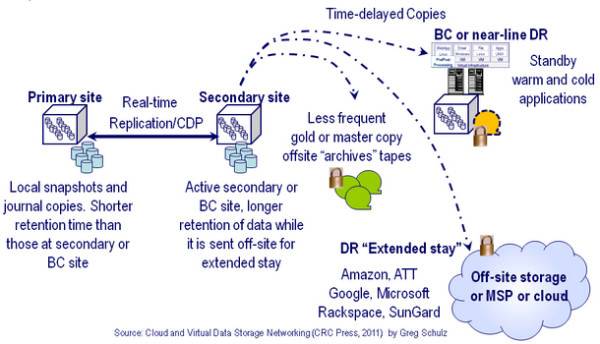Every good company does backups. (But not all — see Are Your Files Backed Up? March 31 is World Backup Day.) This is where online backup comes in handy.

Daniel P. Dern is an independent technology writer. He can be reached at [email protected] and his technology blog is TryingTechnology.com.
Online backup to an off-site service has a lot to recommend it. You don’t have to buy, provision or manage hardware. You only pay for the capacity you use. And if something happens to your computer or premises, you can still get to your data (assuming the online backup hasn’t been impacted by the event).
On the other hand, local backups can save files faster, and let you retrieve large amounts of data faster.
So many companies are doing, or contemplating doing, both types of backups. This makes sense; each provides recovery for different types of events. Plus, even if you prefer local backups, your industry’s regulations may require off-site, online backups.
But many companies, especially SMBs, and enterprise remote and branch offices, don’t have the IT time or resources to manage two separate backup solutions. So many are turning to, or looking at, the new “hybrid” local-and-online backup services.
“There are companies looking to replace onsite backup and move to the cloud, and others looking to double up,” says Greg Schulz, founder and senior analyst of the StorageIO Group. “And some are looking to improve on what they’ve been doing.”
A hybrid backup solution offers simplicity and makes sense — if, cautions Schulz, “that provider can do it all without compromising any of the functions. For example, how well do the local and online components work with each other? They may have different tools that still have to be integrated.”
There’s already no shortage of local backup offerings, which range from software-only you-add-storage to appliances — and online backup services. Many of the online services are MSPs or VARs who in turn are using somebody else’s online storage, e.g., Microsoft, Amazon, or another cloud vendor. Now many of local backup vendors are adding online backup, and vice versa.
How to chose? In addition to checking for the features you want in each piece based on your backup objectives, e.g., CDP (Continuous Data Protection) versus scheduled backups, versioning, retention of files deleted from the primary storage; can open files be saved; agented versus agentless, you need to determine how the local and online components work together. For example, if the local backup fails, will the online portion continue working? Can online backup uploads be scheduled separately to off-prime shifts only?
“What you pick depends on your needs,” says Laura Dubois, Research Vice President, Storage, IDC. “First, it has to be easy to use, because most SMBs have little IT on staff, or even outsource it all. Decide what you want from your backups, e.g., do you want ‘application consistent recovery’ or ‘crash consistent recovery’?” For a small office with just a few PCs and a few GB of data, says Dubois, “You don’t really need to do hybrid, pure online is fine. When you get to larger databases, more servers on site, and multiple terabytes of data, you want a hybrid solution.”
“Be careful,” StorageIO’s Schulz cautions, “For example: whose cloud are they using?”

Sample Hybrid Providers
Companies now offering local/online backup include vendors of hard drives, NAS/SAN appliances, and backup software, along with established online backup providers, along with the bazillions of MSPs, VARs and others reselling these systems and services.
Here’s a quick sampling of hybrid offerings suitable for SMBs (and possibly also for consumers, SOHO, and/or SME RO/BO and enterprises):
Asigra has partnered with Intel to offer Intel Hybrid Cloud backup as part of Intel’s AppUp Small Business Service, allowing small companies to rent rather than buy the local appliance portion.
CA’s new ARCserve D2D On Demand (scheduled for availability in the second half of 2011), will be providing online backup via the Microsoft Azure Cloud. “You install the software on Windows desktops and servers, and first select a local storage target, as the local image will provide fast bare metal recovery, granular application or file level recovery,” says Steve Fairbanks, Vice President of Product Management for the CA Technologies Data Management business. “You then configure critical files and folders to be protected in the Azure Cloud to guard against complete site disaster or theft.
KineticD, thanks to its recent acquisition of Robobak, now also supports local backup. (Disclosure: I’ve been using KineticD for my online backups for several years now. They comp’d my account — small potatoes — but I wouldn’t be using them if they didn’t have the feature mix I wanted and I wasn’t happy with the service. And I don’t think I’ll be able to use their local solution.
EMC’s Mozy MozyHome and MozyPro online backup services now also include the 2xProtect (pronounced “double-protect”) free feature, which does backup to a local drive (which you have to buy, of course)
Netgear’s ReadyNAS systems include the ReadyNAS Vault online backup option, which, via a partnership with Elephant Drive, save to Amazon’s S3 cloud
Seagate i365 uses agents, so if there’s a problem with the local backup device, backups can go directly to the cloud, and then be resynched downwards when the local device is available again. Also, notes George Hoenig, vice president of products and services, Seagate i365, “We make sure that the data center we backup to is in a different ‘geographic risk zone’ from where you are.”
Again, this is only a selective short list of providers. For example, Barracuda and Symantec also offer hybrid local/online backup solutions. Feel free to share your own recommendations in our comments.

















